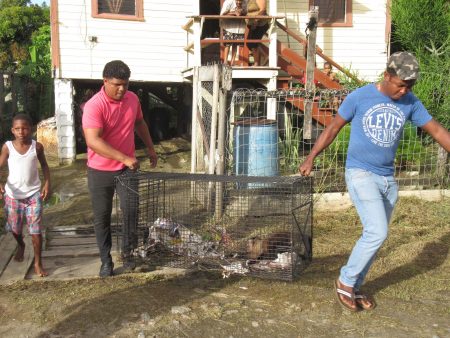Dear Editor,
The residents of Gordon Street, Kitty, were held hostage for over 1 ½ years. The culprit ‒ an innocent monkey brought out of its natural habitat, at a young age, and into an urban environment. It escaped (or more likely was released by humans when they realized how difficult it was to care for wildlife in the city) and had no choice but to take up residence in yards with fruit trees. When this male Capuchin learned that fruit in the city grows on kitchen tables it began to ransack neighbourhood homes. It entered through doors, windows and even squeezed between burglar bars – at any time of day or night. After more than a year the residents had had enough. They tried everything they could think of to catch the monkey but he outsmarted them. They set a molasses trap, called wildlife traders and the wildlife division of the Ministry of Agriculture but all to no avail – no one could catch this vandal monkey.
 At their wits end, one of the Kitty residents called the Guyana Zoo and spoke to animal husbandry supervisor, Prince Dryden. Prince knew I had a large dog trap (donated by Kevin Granger) and that I had successful experience in catching a female and male wild Capuchins in Queenstown in 2016 (both successfully returned to their natural environment). We talked and during the third week of November 2017, we took the trap to Kitty. We spoke to local residents who described their problem. Several were living in airless houses because they were afraid to open their doors or windows. Others had installed chicken wire on their windows. One told me she had to keep an eye on her clothes line to keep the monkey from stealing the clothes pins. They told us how the monkey would sneak into homes, open the fridge, grab milk or cheese and run off into the trees. One neighbour had chickens and said the monkey would steal the eggs, costing her money. Another said the monkey would tease stray dogs by pulling their tails and how once he saw the monkey swinging from tree to tree with a baby kitten in its arms. While we listened to these stories, the monkey was sitting in a tree no more than 10 feet away listening and taunting us with a menacing look on his face. Everyone agreed, he was one super-smart monkey!
At their wits end, one of the Kitty residents called the Guyana Zoo and spoke to animal husbandry supervisor, Prince Dryden. Prince knew I had a large dog trap (donated by Kevin Granger) and that I had successful experience in catching a female and male wild Capuchins in Queenstown in 2016 (both successfully returned to their natural environment). We talked and during the third week of November 2017, we took the trap to Kitty. We spoke to local residents who described their problem. Several were living in airless houses because they were afraid to open their doors or windows. Others had installed chicken wire on their windows. One told me she had to keep an eye on her clothes line to keep the monkey from stealing the clothes pins. They told us how the monkey would sneak into homes, open the fridge, grab milk or cheese and run off into the trees. One neighbour had chickens and said the monkey would steal the eggs, costing her money. Another said the monkey would tease stray dogs by pulling their tails and how once he saw the monkey swinging from tree to tree with a baby kitten in its arms. While we listened to these stories, the monkey was sitting in a tree no more than 10 feet away listening and taunting us with a menacing look on his face. Everyone agreed, he was one super-smart monkey!
We set up the dog trap, adjusted the floor based trigger behind which we hung plenty bananas. For four days we waited. The only news was that the bananas were disappearing every day but no one saw the monkey enter the trap. We all thought, it must be true: “This Capuchin is smarter than we are!”
We were told of another location frequented by the monkey so we changed our strategy. Since we knew he liked to steal eggs, we put the trap in the new location with several eggs behind the trigger release. We semi-covered the trap and put some newspapers over the trigger. We left the trap and drove off wondering if we were smart enough to catch this monkey. Thirty minutes later we got the call, “monkey in the trap”. Prince Dryden and I went back to the site and loaded the monkey, in the trap, onto our vehicle and took him to the zoo. He was kept in quarantine for a few days and then released on Monkey Island at the Guyana Zoo.
Many thanks to the zoo workers, Leslie Short and Carl Blair for their support, Prince Dryden who knows the importance of team work, and Kevin Granger for donating the large trap.
Yours faithfully,
Syeada Manbodh









